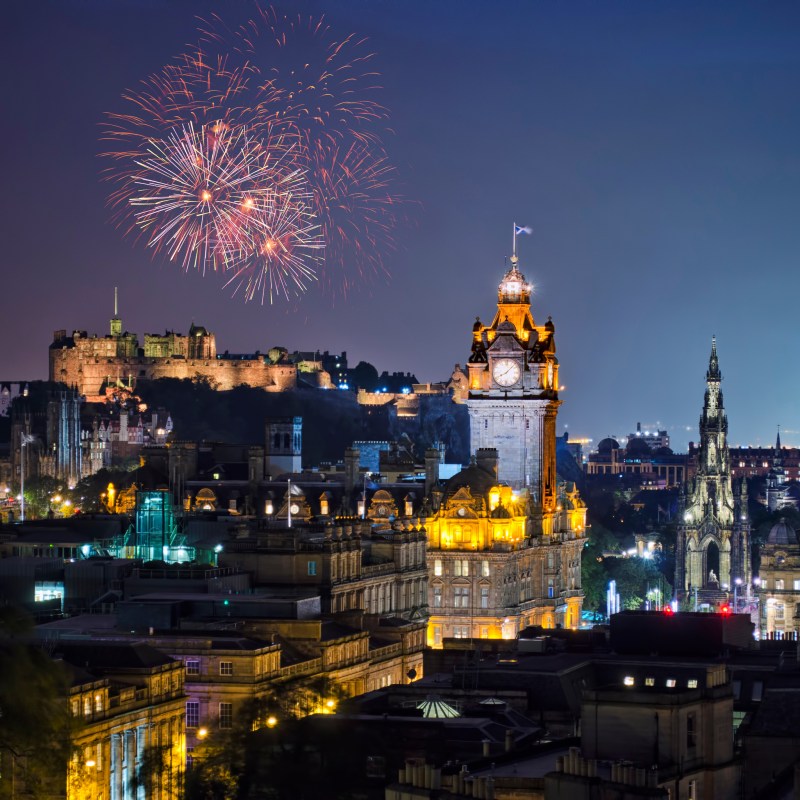
Christmas was banned in Scotland in 1560 when the country split from the Catholic Church. Even singing Christmas carols was a serious crime! It wasn’t until 1958 — nearly 400 years later — that Christmas became a public holiday. As a result, New Year’s festivities dominated the winter festivities for centuries.
Videos by TravelAwaits
And the Scots really do it up! New Year’s celebrations are called Hogmanay (hog-muh-NAY), although no one knows why. It could be from hoguinan, an old French word for a New Year’s gift. Or homme est ne, meaning “man is born.” Or og maidne, Gaelic for “new morning,” hoog min dag, Flemish for “great love day,” or haleg monath, Anglo Saxon for “holy month.”
Whatever its origin, several centuries-old traditions are still celebrated today — in this order:
1. Redding The House
Redding — or “readying” — the house for the New Year involves a deep clean. Fireplaces are swept, a new fire is laid, and the old ashes are “read” (like tea leaves) to predict the coming year. Any lingering spirits and diseases are cleared with a smoking juniper branch carried from room to room. The redding also includes clearing all accumulated debts, which was probably easier in the days before Christmas shopping!
2. Fire Festivals And Torchlight Parades
To ward off evil spirits, “burn the old year out,” celebrate the sun in the days following the winter solstice, or bring luck for fishermen, Scots in Stonehaven, Comrie, Biggar, and, more recently, Edinburgh carry torches through their towns to contribute to a huge central bonfire. In Biggar, the bonfire is lit in the town’s central square, surrounded by shops and homes. Celebrants in Comrie, the UK’s earthquake capital, light birch tree trunks at the stroke of midnight and carry the huge torches through the village before tossing them into the River Earn.
But by far the scariest of these events is Stonehaven’s fireball swinging parade. In this small fishing village about 15 miles from Aberdeen, men and women fill wire baskets with their own secret mixture of flammable materials that burn as long as possible. At midnight, they take to the streets, whirling their balls from five-foot-long wire handles, sending sparks into the nearby crowd.
On December 30, thousands of people in Edinburgh join the torchlight procession through the historic old town, along the Royal Mile and past Holyrood, Queen Elizabeth’s Scottish residence, and end in Holyrood Park.
Of course, all these parades involve bagpipes, drums, and plenty of kilts!
3. Auld Lang Syne
As any proud Scott will mention, this worldwide New Year’s Eve chestnut was written by the Scottish poet Robert Burns. What most Scots don’t know is that it was a Canadian bandleader who made the song famous. Every year from 1929 to 1977, Guy Lombardo’s orchestra performed the song on his U.S. radio and TV shows at the stroke of midnight, landing the song in the Guinness Book of World Records.
To sing the song like a true Scot, join a circle and clasp hands with the person on either side of you. During the last verse, cross your arms across your chest and once again link hands with your neighbors. At the end of the song, rush to the middle of the circle, still holding hands.

4. First Footing
After parading with fire and slurring Auld Lang Syne, Scots then visit their neighbors’ scrubbed homes for a wee dram of whisky. The first visitor of the new year is said to dictate the fortunes for the whole year — and the ones who bring the best luck are tall, dark-haired strangers. This is because back in the days of the Viking invasion, a red-headed stranger on one’s doorstep was very bad news.
Nowadays, the tradition is practiced among friends and neighbors. But it’s considered rude and bad luck to show up empty-handed. Visitors bring a coin, shortbread or black bun (a type of fruit cake), some whisky (Scots spell it without the “e”), and a lump of coal for that newly laid fire. These gifts bestow prosperity, food, cheer, and warmth for the coming year.
5. Saining Of The House
This rural tradition is the New Year’s blessing of the house and livestock with water from a local stream. Following the water blessing, the woman of the house purifies each room with a smoldering juniper branch, filling the house with smoke. Everyone then throws open the windows to allow in the new year air — and partake in a few wee drams of whisky.
More recently, newer traditions have augmented the old rituals — and some of them are just as weird!

6. Loony Dook
On New Year’s Day, a thousand people shake off their hangovers by donning fancy dress and throwing themselves into the frigid Firth of Forth, the estuary on the North Sea just north of Edinburgh. This eyebrow-raising ritual started by a few intrepid locals in 1987 has now grown into an international event.
Pre-registration, which opens the previous September, and a fee are required to attend as a participant. Fees support the Royal National Lifeboat Institution. The time of the parade and group dunk (called the dook) differ each year, depending on the tide. But attending as a spectator is free and no pre-registration is required.
Pro Tip: The beach is rocky rather than sandy, so wear sturdy shoes. To fit in, wear something wacky!
7. Ceilidh
Here’s where the Scottish whisky helps: Dancing to a Scottish ceilidh, which is similar to a fast square dance. Pronounced “KAY-lee,” these reels feature fiddlers who call out the steps. While ceilidhs, which include folk singing and storytelling, are held year-round, they have traditionally been part of New Year’s festivities and are held anywhere from casual village halls to formal castles and hotels.
On a dare, I danced in a ceilidh in Glen Isla, a small village an hour and a half from Edinburgh. It was a blast! I was the only tourist there, clad in my host’s tartan, encouraged by my friends’ offerings of wee drams of Scotch. My missteps — often! — were laughed off as it was all part of the fun and comradery.
Recently, Edinburgh has added a New Year’s ceilidh under Edinburgh Castle to its Hogmanay festivities.

8. Edinburgh Street Party And Concert
Billed as the world’s best street party, Edinburgh’s Hogmanay boasts 60,000 revelers from around the world who join for a six-hour party that features internationally famous live bands on several stages, and street performers, such as dancers, acrobats, and fire eaters. Streets are closed to accommodate the food and drink stalls and the celebrating crowd.
The Princes Street Gardens hosts big-name performers in the Concert in the Gardens. This is a ticketed, outdoor event, so buy your tickets early and dress warmly!
9. Celebrating In A Smaller Edinburgh Venue
If big crowds aren’t for you, Hogmanay is celebrated in smaller venues around Edinburgh with concerts and other performances. Check out the festivities at Usher Hall, The Assembly Rooms, the Queen’s Hall, Church Hill Theatre, the Scottish Storytelling Centre, and hotels and restaurants such as Ghille Dhu.
10. Fireworks
And, of course, fireworks light up many cities’ midnight festivities with a bang!

11. Eat (And Drink!)
Scottish celebrations often include a wee dram of whisky, and Hogmanay is no exception. The ancient Celts called it uisge beatha, the water of life, and that “water” flows freely during Hogmanay.
Although single malt whisky can be distilled anywhere (and is), it can be called “Scotch” only if it is distilled in Scotland. But the irony is that, nowadays, Scotch is aged in barrels that come from Kentucky’s bourbon distilleries!
To soak up all that Scotch, there are several special foods that help Scots ring in the new year.

The signature Hogmanay dish is black bun, which is like a fruit cake baked with raisins, currants, almonds, citrus peel, allspice, ginger, cinnamon, and black pepper, then wrapped in a layer of pastry. Many descriptions of black bun suggest it pairs well with whisky — but I suspect all the foods listed here do, as well!
Steak pie is a party favorite and is just what it sounds like — savory pieces of steak encrusted in a flaky pastry. You buy them at the butcher’s and pay by the weight of the pie. Venison pie is a rich favorite.
A feel-good addition to any Hogmanay meal is neeps and tatties — turnips and potatoes mashed with lots of butter — or rumbledethumps, a baked potato and vegetable dish.
Another holiday favorite is cock-a-leekie soup, a hearty soup of leeks, chicken stock, rice and a handful of prunes.
For dessert, Scots treat themselves to buttery shortbread served with cheese, tipsy laird trifle (a cold sponge cake layered with fruit, custard, jelly, and cream, and drizzled with generous amounts of whisky — hence the “tipsy”), a clootie dumpling (a fruit and spice pudding), or cranachan (a parfait of toasted oatmeal, honey, Scottish raspberries, whipped cream, and, of course, whisky).
And then there’s haggis, the Scottish national dish that is made with sheep heart, liver, and lungs. I’ve heard it’s quite delicious, but haven’t had enough whisky yet to give it a try myself!
12. Sleep In
Sober up after all that partying with a proper Scottish “lie-in.” Unlike the rest of the UK, Scots get an extra day to recover from all this revelry: Everything is closed on January 2. Be sure to stock up by December 31!
Pro Tips To Ensure “A Guid New Year”
Since many of Hogmanay’s celebrations occur outside after sunset, be sure to dress warmly — and comfortably, as many events involve standing only. Streets are often uneven cobblestones, so wear sturdy shoes.
To join Edinburgh’s Hogmanay events, which differ each year, visit the official website for updated information and book tickets months ahead. Lines to pick up tickets and wristbands are long.
Or check out Glasgow’s Hogmanay events.
Further Reading:
